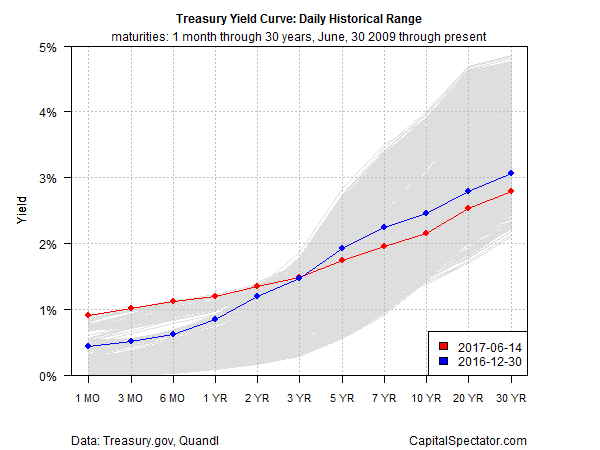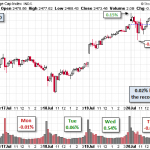The Federal Reserve on Wednesday hiked interest rates again, asserting that moderate economic growth will continue for the foreseeable future. But confidence appeared to be in short supply via the benchmark 10-year Treasury yield, which slumped amid rising demand for this safe-haven asset.
Tighter monetary policy doesn’t usually promote a robust round of bond purchases, but yesterday’s trading broke with tradition. The 10-year yield fell for the first time in over week, dropping six basis points to 2.15% yesterday (June 15), close to a seven-month low, based on daily data via Treasury.gov. As recently as mid-March, the 10-year rate was above 2.60%.

The latest slide in the 10-year continued to squeeze the yield spread. The widely followed 10-year/2-year spread, for instance, fell to 80 basis point, the lowest since last September.

The net result: a flatter Treasury curve generally. The shift is conspicuous this year, with short rates up to the 2-year maturity rising year to date while yields for 5-years-plus maturities have fallen since last year’s close.

A flatter yield curve has traditionally been a warning sign for the economy, although only an inverted curve – short rates above long rates – is an outright danger sign that a new recession is near. By that standard, the Treasury market is currently forecasting softer growth but no recession.
Fed Chair Yellen reasoned that raising interest rates – yesterday’s increase lifted the central bank’s benchmark by a quarter point to a 1.0%-to-1.25% range – is warranted due to ongoing economic growth. Yesterday’s decision “reflects the progress the economy has made and is expected to make toward maximum employment and price stability,” she explained in a press conference.
But she also left the impression that the Fed is eager to raise rates, in part, to preserve the ability to cut when the next recession strikes. The rationale is also bound up with the logic that leaving rates too low for too long might back the Fed into a corner if economic growth and/or inflation accelerates, which would force a series sharp rate hikes in a relatively short period. In turn, that could trigger a recession, Yellen said. Gradually raising rates, by contrast, minimizes the danger.












Leave A Comment